Key words
HIV, AIDS, knowledge, attitudes, sexual behaviour, student nurses
Introduction
Although it is considered that nowadays there is adequate knowledge about transmission of HIV, published figures show an increase in the number of HIV positive people and individuals suffering from AIDS [1]. The increase in cases detected might be due to the reduction of information given to the general population [2]. Healthcare professionals including nurses have significant responsibility for providing information about the transmission of HIV and for developing a strategic health programmes to reduce that transmission. Student nurses will have received some information about HIV and AIDS before commencing their undergraduate studies. Through their nursing education and clinical training they should acquire knowledge that will change their attitudes and influence their behaviours both in the prevention of transmission of the virus, and positive attitudes for effective caring for these patients.
With the continuing increase in the incidence of HIV and AIDS nurses require current knowledge and skills to ensure that they are able to provide high quality, effective care to people living with HIV and AIDS [3,4].
Studies carried out in the early nineties showed that nursing students had a low level of knowledge with respect to HIV and AIDS [8,9]. A study carried out in Turkey was found that the majority of nursing students had moderate level of HIV/AIDS knowledge [10]. Lack of knowledge among nursing students found in other studies as well [11,12]. Bektas [10] found that some nursing students were not aware that there was no protection with vaccination. In addition found that there are many misconceptions about how HIV is transmitted e.g using the same toilet or bathroom etc. [10]. This problem also stressed by previous researchers [13,14].
Male and older students were found to be more knowledgeable than female and younger students [9]. Bliwise et al. [15] found that nursing students and first year medical students possessed greater fear of contagion, more negative emotions and professional resistance to care for these people. In contrast, to previous result Halpern et al.’s [16] study found that health care professionals and nursing students did not have fears of HIV/AIDS and did not judge individuals with HIV/AIDS in a negative way.
Previous experience in caring for an AIDS patient was found to increase the level of nurses’ knowledge and to reduce the fear of contagion [17]. Knowing someone with AIDS resulted in a higher knowledge level and less fear of HIV/AIDS [18]. Students who had previous experience in caring for an AIDS patient and had known someone with HIV/AIDS were willing to care for PLHIV [10].
Student nurses are usually more willing to care for patients who are not diagnosed with AIDS. Particularly students having negative attitude towards care for AIDS patient were worried about putting their family members and other relatives at risk [19].
Nursing students with negative attitudes were less willing to care for people with HIV/AIDS compared to those with positive attitudes [3,20]. Moreover, the higher the knowledge level regarding AIDS, the more positive were the attitudes and the higher was the willingness to care for AIDS patients [19].
Knowing someone with and caring for AIDS was also found to decrease the fear and increase the knowledge level and willingness to care for such a patient [10]. This finding is similar to those reported by previous studies [17,18]. In Bektas’ [10] study there was a substantial negative attitude towards AIDS and HIV positive patients. Nursing students found unwilling to care for AIDS patients which was linked to the fear of contracting HIV/AIDS which is consistent with earlier studies [17,18,21]. O’
Sullivan found that those who were least willing to care for HIV feared for their personal safety and did not feel adequately prepared to care for PLHIV [22]. Goldenberg & Laschinger [19] did not found any association between nursing student age and their attitudes towards AIDS patients.
People’s attitudes towards AIDS may also affect their own sexual behaviours. A minimal concern about contracting HIV together with high sexual activity is associated with a lower level of safer sex practices [11]. Female student nurses practice more safe sex compared to male nurses [23].
Studies investigated attitudes towards AIDS patients showed that people being afraid of HIV/AIDS had higher homophobia compared to those with less fear of HIV/AIDS [17,24]. Infection of HIV was often considered as a punitive consequence of a promiscuous sex life with nurses and nursing students having little sympathy for homosexuals suffering from AIDS [25]. Lohrmann et al. [11] referring to a German study [26] reported that more experienced nurses did not discriminate between groups of AIDS patients in terms of lifestyles.
Results from Bektas [10] study underline the need to strengthen education on all aspects of HIV/AIDS. To improve nursing students willingness to care for PLHIV, particular emphasis should be placed on the training of nursing students as skilled nursing staff with humane attitudes towards PLHIV [10]. The educational preparation of nurses has been known to affect the attitudes of the nurses and the effectiveness of the care provided to HIV/AIDS patients [10].
Namal [27] indicated that the subject of AIDS is not mentioned enough in medical and nursing schools and people with AIDS are simply identified as homosexual. Nurse educators should ensure the education on all aspects of HIV/AIDS is explicitly included in the curriculum and that the teaching reflects the needs of leaners.
The study
The purpose of this study was to explore Greek nursing students’ knowledge levels and attitudes related to HIV/AIDS.
Objectives:
1. To identify the sources of information that nursing students access in relation to HIV and AIDS.
2. To identify willingness to care for people with AIDS
3. To explore the factors associated with knowledge and attitudes about AIDS among nursing students in Greece.
4. To identify nursing students sexual risk behaviours .
Methods
Study design
This study utilized a descriptive cross-sectional survey design to collect data from Greek nursing students, using a self-administered questionnaire. The data were collected in January 2009. Study participation was anonymous and voluntary.
Sample and research site
The study population consisted of a convenience sample. A total of 279 Greek student nurses (N=279) of first (1st), third (3rd), fourth (4th) and sixth (6th) semester studies participated in the study with 77.5% response rate. Participants were studying general nursing in a nursing school of a Technical Educational Institute which belongs to the higher education system in Greece. The duration of nursing studies was 8 semesters. The researchers approached students in their classrooms and invited them to participate in the study. After explaining the purpose of the study the researchers distributed a self-administered anonymous questionnaire to students who were willing to participate in the study. In addition, the students were reassured that their responses would be confidential and their participation was voluntary. Moreover, the nursing students were informed that they were free to withdraw from the study at any time. The completed questionnaires in sealed envelopes were collected by researchers in a box within a period of 3 weeks.
Instrument
The questionnaire consisted of four self-administered instruments that took a total of 10 minutes to complete. The instruments of this study were (a) the International AIDS questionnaire-Chinese Version (IAQ-C), (b) the source of HIV/AIDS information questionnaire, (c) Sexual behaviours/practices and attitudinal questions about AIDS and (d) demographic questions.
International AIDS Questionnaire - Chinese Version
The International AIDS Questionnaire – Chinese Version (IAQ-C) was developed and validated by Davis, Tang, Chan, and Noel [28] for use with a Chinese population. It measures four dimensions of HIV and AIDS: transmission myths, awareness—factual knowledge, attitudes and personal risk. Each item was scored on a 5-point likert scale: 1 (strongly agree), 2 (agree), 3 (don’t know), 4 (disagree), 5 (strongly disagree). Total scores on the IAQ-C ranged from 18 to 90, and subscale scores ranged from 7 to 35 for transmission myths, 5 to 25 for attitudes and 3 to 15 for personal risks and factual knowledge. Higher scores indicated positive and accurate views of HIV. Cronbach’s coefficient alpha estimated by Davis et al. [28] found a=0.76. In the present study, the Cronbach’s alpha coefficient was a=0.76. The IAQ-C also examined for validity by a group of experts and had proved that it had face and content validity.
Source of HIV/AIDS Information Questionnaire and sources of Communication
The questionnaire developed in a previous study [2]. Respondents were asked to declare what sources they use to get information regarding HIV and AIDS. In addition, they asked with whom they would discuss questions about HIV.
Sexual behaviours/practices and attitudinal questions about AIDS
Participants asked to report their sexual behaviours and practices. The questionnaire incorporated some questions derived from the literature review which were considered essential for the present study. In particular, nursing students asked to respond with yes or no in attitudinal questions regarding AIDS.
Demographic and personal questions
Demographic questions were also included with respect to sex, age, semester of studying, nationality, personal status, health perception, religion and religiosity.
A back translation was performed in all translated questionnaires and minor changes were made in order to make sense in Greek language.
Pilot study
The feasibility and acceptability of the questionnaire was tested in a pilot study of 20 student nurses from semesters which were not involved in the main study. Overall the pilot study showed that no major changes in structure or content of the questionnaire were needed. One item in HIV Knowledge and attitudes questionnaire was modified to be more relevant with the Greek population. In particular, item Asians are less susceptible to contracting AIDS than Westerners was modified to Greeks are less susceptible to contracting AIDS than other nationalities.
Ethical issues
Students were informed about the purpose and the benefits of carrying out the study and advised that participation was voluntarily, and the questionnaire was anonymous. Students were advised that they could decline to participate or could withdraw at any time without detriment to their studies and were informed that the completion of the questionnaire implied consent to participate in the study.
Data analysis
Descriptive and inferential statistics were used in analyzing the data. Chi-square tests were utilized to identify the relationships between gender and sexual related behaviours. One way analysis of variance was performed to compare the nursing student nurses’ level of knowledge and attitudes in relation to some variables. P value was determined at level of P<0.05. Statistical analysis was performed using SPSS for windows version 17.
Results
Sample
A total of 279 nursing students in their 1st, 3rd, 4th and 6th semesters participated in the present study. Of the respondents 16.1% (n=45) were male and 83.9% (n=234) were female. Table 1 presents the characteristics of the sample and provides information on personal characteristics. Participants ranged in age from 18 to 37 years with a mean age of 20.86 years (SD=2.53). The majority of nursing students were in either their 6th (n=94/33.6%) or 1st (n=81/29%) semesters, whilst less students were in their 3rd (n=57/20.4%) or 4th (n=47/17%) semesters. Most of the respondents (n=165/59.1%) stated that they had permanent relationship with a partner, 30.9% (n=86) stated that they hadn’t a relationship and fewer stated that they had casual relationships. With respect to respondents’ nationality the majority were Greek (n=262/94%), 2.5% (n=7) were Albanian, 1.1% (n=3) were Cypriots and 2.2% (n=7) not stated. Of the participants 16.1% (n=45) rated their health as excellent, 42.7% (n=119) as very good, 33.3% (n=93) as good, 6.8% (n=19) as failing and 1.1% (n=3) as poor. The majority of the respondents (146%/n=52.3) rated themselves as religious or fairly religious (29.4%/n=82) with a proportion of 7.2% (n=20) as not at all religious. In regard to religious preference the majority of nursing students (94.3%/n=263) were Christian and 1.4% (n=4) were Muslim.
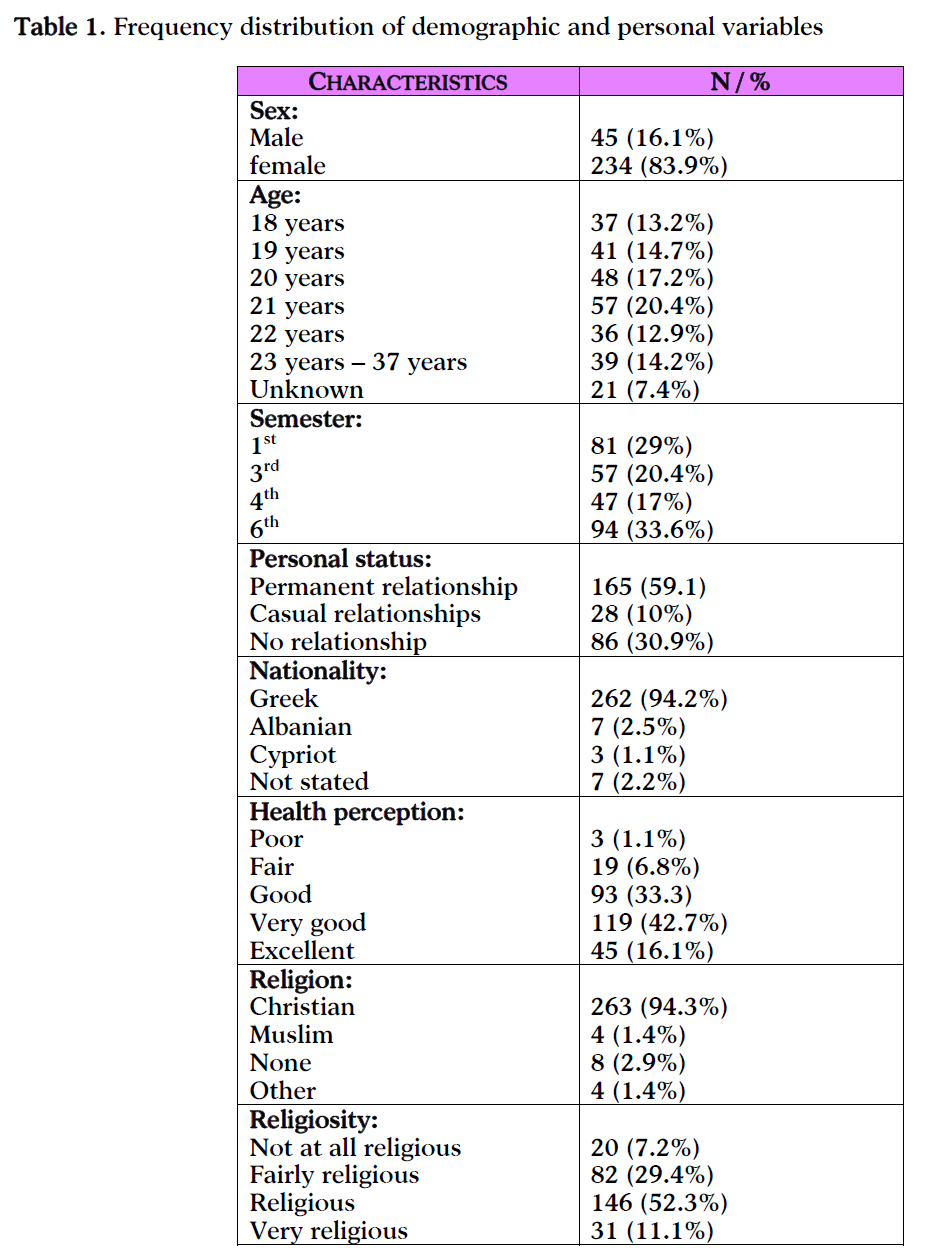
Knowledge and attitudes about HIV/AIDS
Table 2 illustrates the data related to knowledge and attitudes about HIV/AIDS amongst Greek Nursing students studying in a Technological Educational Institute in Greece. The mean score of transmission myths subscale was 27.59 (SD=7.02), 12.68 was for facts subscale, (SD=3.19, possible range 7-35) 10.49 was for personal risk subscale (SD=3.29, possible range 3-15) , and 19.63 for attitudes subscale (SD=4.93, possible range 5-25). The total mean score of the questionnaire was 70.39 (SD=18.43).
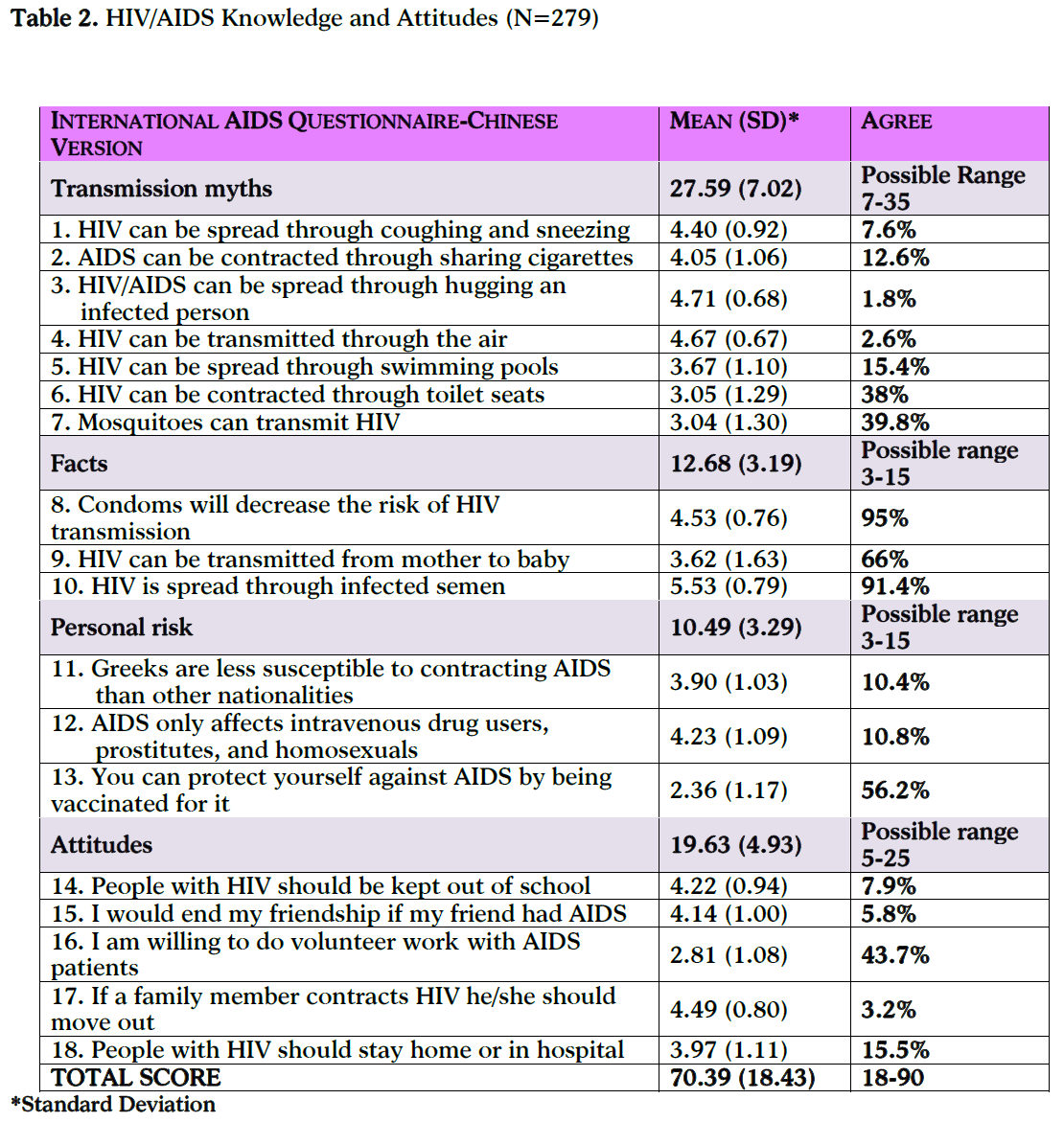
Transmission myths
Of the respondents 39.8% believed that HIV can be transmitted through mosquitoes, 38% through toilet seat and 15.4% agreed that HIV could be spread through swimming pools. 12.6% believed that HIV could be contracted through sharing cigarettes, 7.6% through coughing and sneezing, 2.6% through air and 1.8% through hugging an infected person.
Facts
The majority of participants (95%) believed that the use of condoms could decrease the risk of HIV transmission. 91.4% of the respondents believed that HIV could be spread through infected semen and 66% that HIV could be transmitted from mother to baby.
Personal risk
Of the participants 56.2% believed that they could protect themselves against AIDS by being vaccinated for it. 10.8% believed that AIDS only could affect intravenous drug users, prostitutes, and homosexuals, while 10.4% believed that Greeks would less susceptible to contracting AIDS than other nationality.
Attitudes
Nearly half of the respondents (43.7%) were willing to do volunteer work with AIDS patients. Only 3.2% agreed to move out a family member if they were HIV positive. 15.5% agreed that people with HIV should stay home or in hospital. Of the respondents 7.9% agreed that people with HIV should be kept out of school, while 5.8% agreed that they would end a friendship if their friend had AIDS.
Sources of HIV/AIDS information and sources of communication
The majority of the participants (80.7%) stated that the main source of information about HIV and AIDS was television (Table 3) newspapers and magazines were sources of information for 64.6% of the participants. A noticeable percentage (60%) of the respondents reported the internet as a source of information. Nearly half of the respondents (57.9%) reported school teachers in High school or Lyceum as a source of information, 57.5% reported nursing books, 52.9% reported nursing lecturer, 51.8% reported gaining information from a health professional, 45% from a friend, 43.2% from a friend, 19.3% from the radio, as well as 9.6% from a primary school teacher.
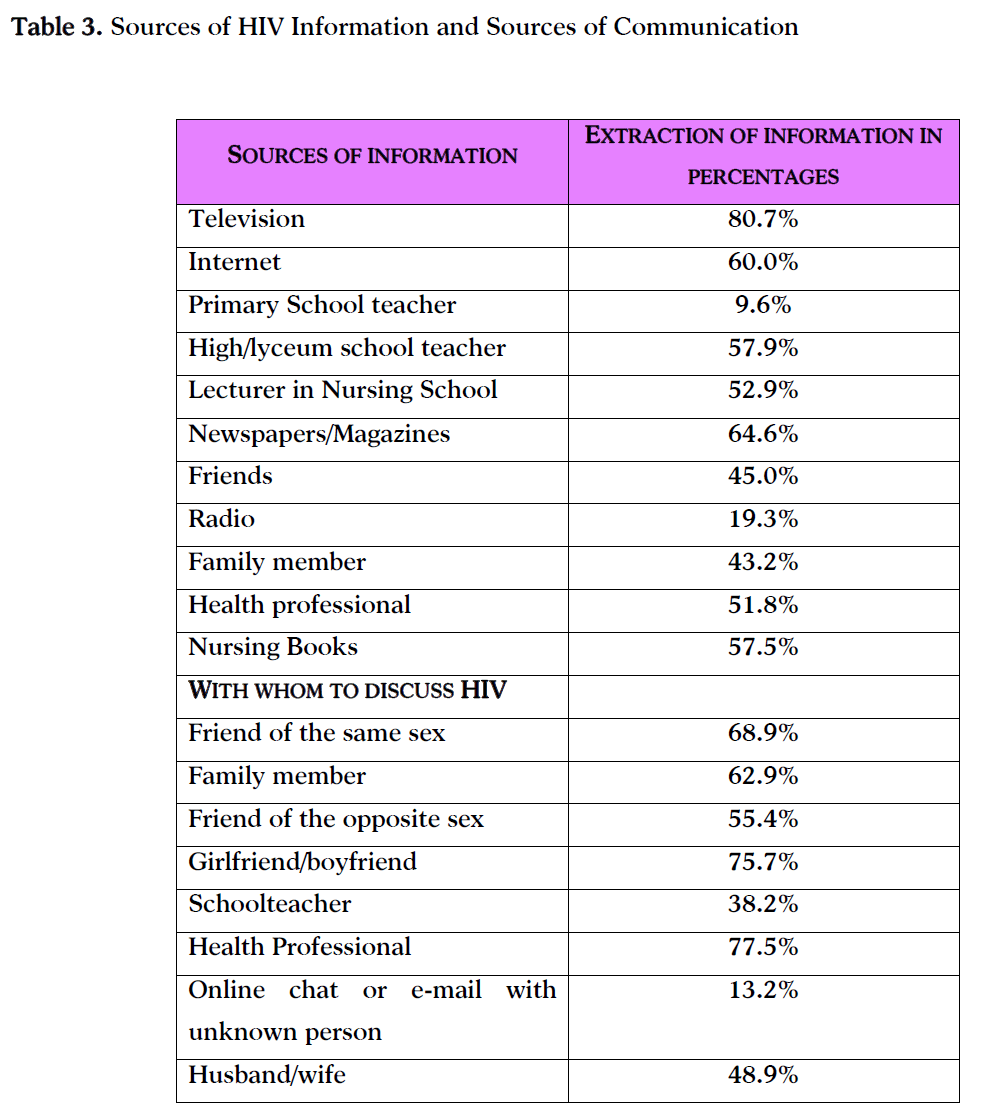
With respect to whom to discuss about HIV the majority of respondents (77.5%) reported that they would discuss with a health professional (Table 3). 75.7% said they would discuss the subject with their boyfriend or girlfriend. 68.9% reported that they would discuss with a friend of the same sex, 62.9% with a family member, 55.4% with a friend of the opposite sex, 48.9% with a husband or wife, 38.2% with a school teacher and 13.2% with online chat or email with unknown person.
Respondents’ sexual behaviours
The results of the study showed that the vast majority of the respondents identified themselves as heterosexual (Table 4). Only two male nursing students (n=2/0.7%) reported as homosexual and one female (0.4%) respectively). Of the participants the majority 80.7 % reported that they had sexual experiences. Of the female nursing students 15.8% (n=44) reported never engaging in sexual activities. 23% of the male respondents reported that had four or more partners in their life and 26.5% of the female reported that they had two or three partners. Only 1.1% of male and 24% of the female reported one partner. 18 of the 45 male participants (6.5% of the total sample) and 24.4% (n=68) of female respondents said that they used a condom every time. Of the respondents 12.6% (males) and 52.8% (females) reported that they drink alcohol sometimes, while 28.8% (female) of the total sample didn’t drink at all. As illustrated in table 4 the majority of nursing students did not use drugs at all.Chi-square tests indicated that male respondents reported more homosexual in comparison to female but it was not statistically significant. However, male students had significantly more sexual experiences in relation to female (97.8% vs 78.4%;X2 = 10.06, df=4, P=0.03). In addition, female students reported more relationships with only one partner in their life when compared to males students (29% vs 6.7%; X2 = 34.59, df =8, P=0.001). Significantly more male students reported the use of condom every time they have intercourse (40% vs 29.4%; X2 = 34.91, df=8, P=0.001). Similarly, male respondents reported that they consumed alcohol and drugs more often than the female respondents (2.2% vs 1.3% X2 =281.89, df=6, P=0.001).
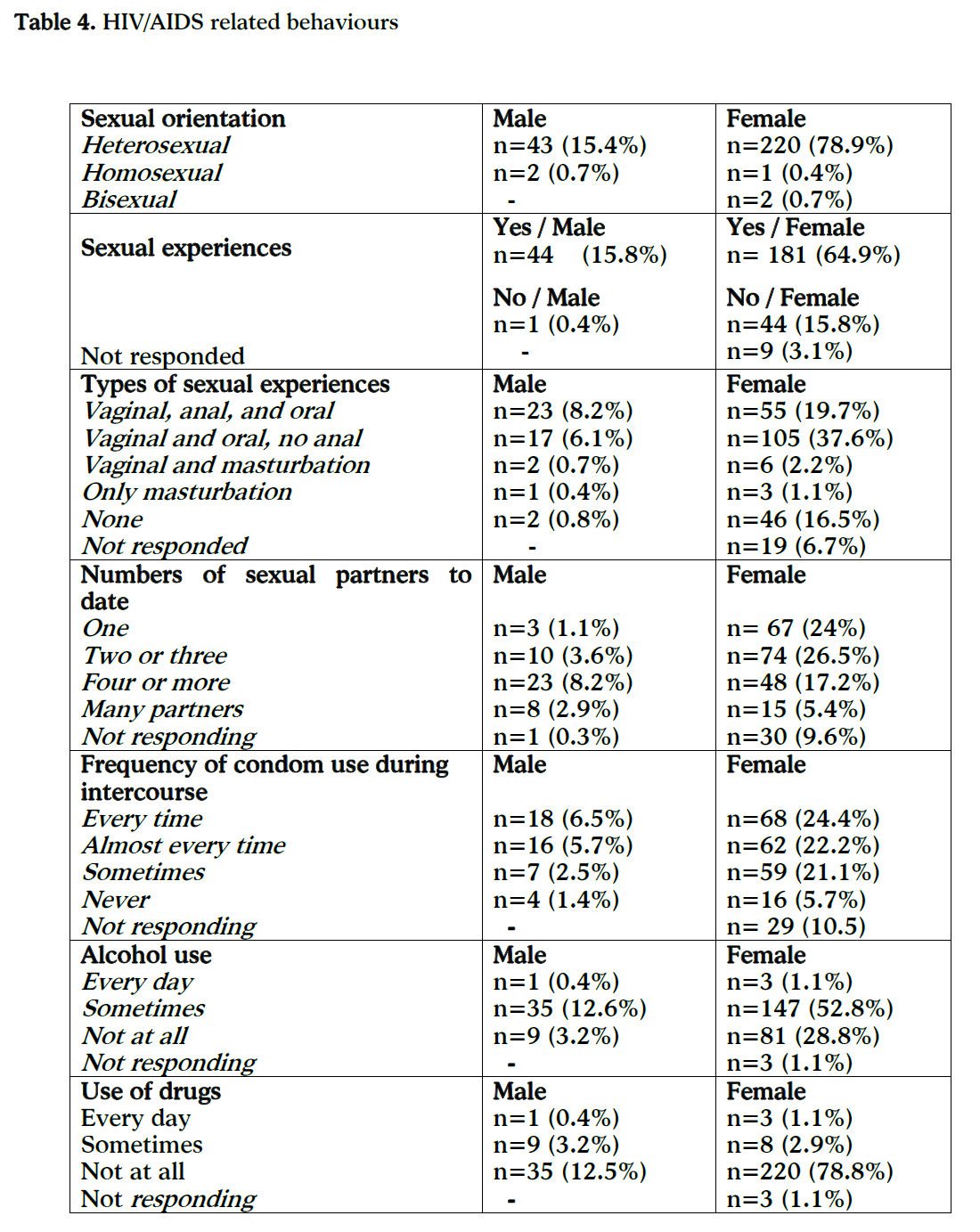
Factors associated with attitudes towards HIV/AIDS
Female respondents and older students were found to be more knowledgeable with more positive attitudes about AIDS when compared to male students. However the difference was not statistically significant. Moreover, there were no significant differences in knowledge and attitudes in relation to semesters of study. One way analysis of variance revealed that respondents who reported themselves as not at all religious were found to be more knowledgeable regarding HIV and AIDS (F=2.61; P=0.03) and they maintained significantly more positive attitudes than those reporting religious beliefs (F=2.61; P=0.03).
Nursing students also asked if they would continue to have contact with a relative or a friend who told them that they had AIDS. Results found that the majority of respondents would continue having contact with a relative (F=26.580; P=0.001) or a friend (F=7.834; P=0.001) as before. In addition, these respondents held more positive attitudes towards people with AIDS with a statistical significant difference compared to participants reported that they wouldn’t continue having contact with relative or friend with AIDS.
Participants were also asked if in clinical training they knew that a patient was HIV positive would they provide care for them (Fig. 1). The majority reported that they would provide care (76.1%). Nearly one fourth of respondents reported that they would avoid the patient (22.80%) and 1.10% stated that they wouldn’t provide care for AIDS patient. A Chi-square test showed that respondents willing to care for patients with HIV or AIDS had significantly better knowledge about measures to take when caring for AIDS patient (68.1% vs 67.7%; X2 = 283,203, df =4, P=0.001) In contrast, participants reporting that they would avoid caring for the particular patient, stated that they didn’t know the measures to take for AIDS patients (32.3% vs 31.9%; X2 = 283,203, df =6 P=0.001).
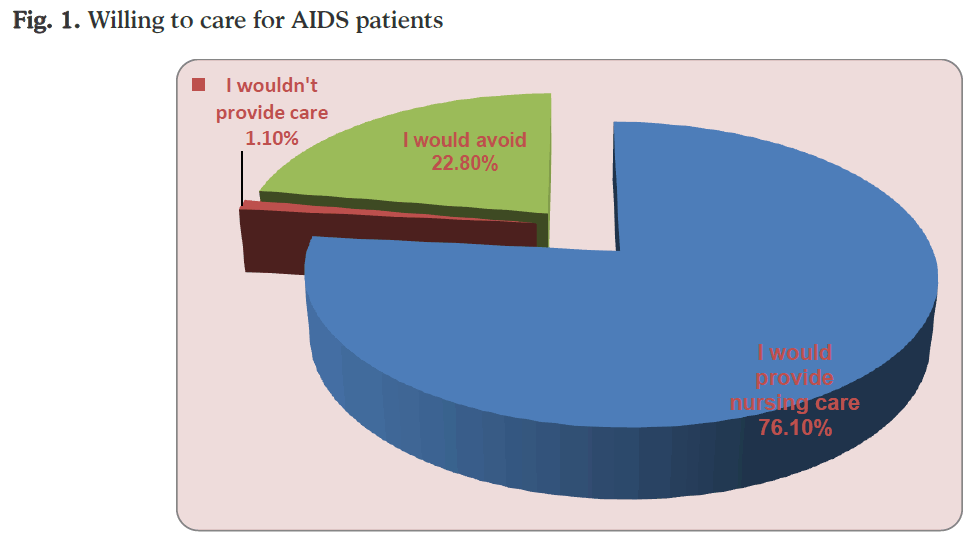
Figure 1: Willing to care for AIDS patients
Respondents were also asked additional attitudinal questions about AIDS (Table 6). Of the participants 91.8% reported that having AIDS was not something to be ashamed of. However, the majority (93.9%) believed that people with AIDS are not accepted by other people. Nearly two third (67%) of the respondents reported that they were informed about the measures to take in order to care for AIDS patients. However, 76.7% of the respondents reported that they hadn’t been taught anything about AIDS during their nursing training.
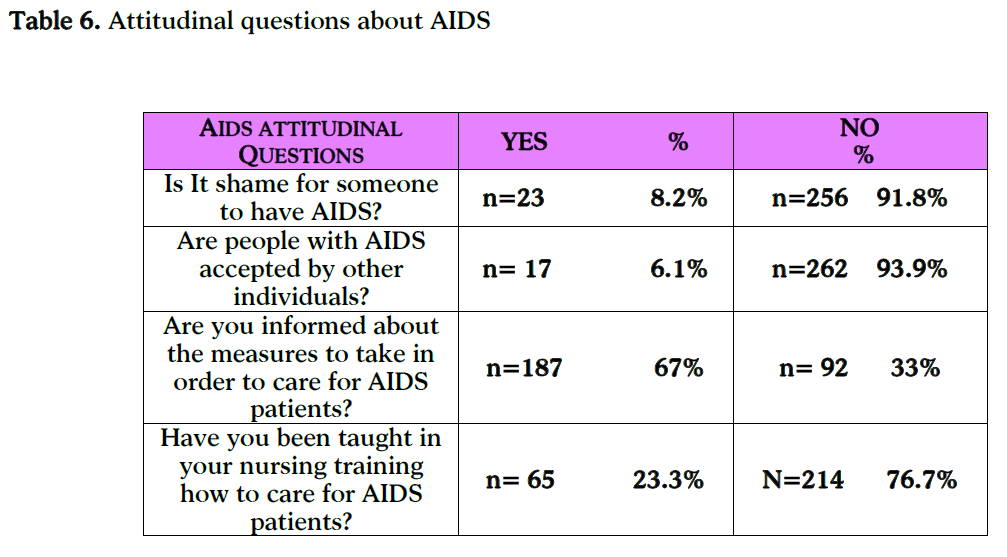
Discussion
The results of the present study showed that participants had fairly good knowledge about HIV and AIDS. However, taking into consideration that the target population of the present study was nursing students, their knowledge on HIV/AIDS was inaccurate and insufficient for future health care professionals. Surprisingly, nearly half of the respondents believed that HIV could be contracted through mosquitoes, one third through toilet seat and a small proportion through swimming pool. In addition, more than half of the nursing students believed that they could protect themselves against AIDS by being vaccinated for it. Studies carried out illustrate similar findings with the present study and concluded that nursing students had low level of knowledge about HIV and AIDS [2,8,9,10,13,14]. The present study conducted in nursing students indicates a limited knowledge about HIV and AIDS and it would be expected that they would hold accurate and sufficient knowledge by the sixth semester of their studies. Nevertheless, there was no difference found between the knowledge and attitudes of nursing students in different semesters. In contrast Bliwise et al.’s [15] study carried out in nursing and medical students found a fear of contagion, negative emotions and professional resistance in 1st year students. This means that they had not gain any knowledge on the subject by the time of their entry into. This can be confirmed in the current study by participants’ responses when they were asked if they had been taught about AIDS during their nursing training, the vast majority reported that they hadn’t been taught how to care a patient with AIDS. With respect to participants attitudes towards people with AIDS the results showed that the majority of students held a positive attitude towards these people, confirming the findings of Halpern et al’s [16] study in which they concluded that student nurses didn’t have a fear of HIV/AIDS and did not judge individuals with HIV/AIDS in a negative way. In the present study, nearly half of the nursing students reported their willing to do volunteer work with AIDS patients. An addition element of favourable attitudes was the respondents’ report in an independent attitudinal question that they would continue to maintain contact with a relative or a friend knowing that they had AIDS. Notwithstanding, respondents surprisingly reported contradictory believes in some attitudinal items of the HIV/AIDS knowledge questionnaire. For instance though the score of the subscale attitudes indicated favourable attitudes and in some items respondents reports implied sympathy, a small proportion reported that people with HIV should be kept out of school. Moreover, people with HIV should stay home or in hospital. In addition, though the majority reported that they would care for a patient with AIDS, an important proportion of the participants reported that they would avoid caring for that patient, while a very small percentage reported that they wouldn’t provide care at all which causes a major professional concern. Similar contradictory results were found in a study carried out in college students [2,10]. The researchers named those results as dichotomous beliefs and justified them because of the lack of knowledge and understanding about HIV [2]. This explanation can be adopted in the present study considering that respondents reported that they hadn’t received adequate training about AIDS. Furthermore, those who reported limited knowledge on HIV and AIDS protections were cautious to provide care for AIDS patients. In contrast, participants who were knowledgeable about HIV and AIDS issues were willing to provide care for AIDS patients. It is obvious that knowledge gives professional confidence to nursing students and competency to manage AIDS patients.
The vast majority of the respondents reported television, newspapers/magazines and internet as primary sources of information with respect to HIV and AIDS. Nearly half of the nursing students reported high/lyceum school teacher, nursing books, lectures in nursing school and health professionals as sources of information. Similar sources of information were found in college students but different information sources would be anticipated for nursing students. Nursing students should be expected to get information mostly from the nursing school and health care professionals during their clinical training allocation rather than from mass media or the internet. It should be stressed that even though participants got information mostly from television and internet there is still lack of knowledge on HIV and AIDS. This result illustrates the current situation in society. The AIDS campaign has been restricted over the past few years and the information provided in television or internet is limited [2,10]. This is reflected in the results of the present study. It worth stressing that although the incidence of HIV positive cases and AIDS has been increasing dramatically, the social message given to people is that the AIDS problem has been resolved or at worst it is under control, this inaccurate message arises from the provision of insufficient information. Moreover there is disproportion between the increasing rate of HIV positive people, AIDS and the limited information provided for the prevention of transmission of the HIV virus.
The majority of nursing students were more likely to discuss HIV related issues with health professionals, boyfriend/girlfriend, friend of the same sex and family member. It would appear that studying nursing encourages participants to search out credible professional advice to discuss HIV related problems. The results also illustrate the HIV/AIDS is more acceptable as respondents were not hesitant to discuss HIV related issues with their boyfriend/girlfriend, with a friend of the same sex or even with a family member. The acceptance of HIV positive people and people with AIDS is successfully illustrated by almost all participants’ response that it is not a matter of shame for someone to have AIDS.
The majority of nursing students were heterosexual and sexually active. From the forms of their sexual experiences it is obvious that the majority didn’t perform risky sexual practices in term of HIV contamination. Male nursing students held more multiple relations during their life, a finding echoed by other studies [10]. The vast majority of male respondents used a condom almost every time they had intercourse. An important proportion of female students also reported the use of condom during intercourse. It is self-evident that the use of condom during intercourse has double benefit. Condom provides protection from HIV and sexual transmitted diseases as well as provides contraception. Therefore, it is not an indication of the use solely for contagious of HIV. The use of alcohol and drug it is not a problem for the participants of the present study as it seems of the result that they use sometimes alcohol and hardly ever drugs.
With respect to gender older female respondents were found to be more knowledgeable with more positive attitudes towards AIDS compared to male nursing students though that difference was not significant. In contrast another study found male and older students to be more knowledgeable than female [9]. Goldenberg and Lascinger [19] did not found any association between nursing students’ age and attitudes towards AIDS patients. Another influential factor determining attitudes towards HIV and AIDS was found to be the level of religiosity. Interestingly, nursing students who reported no religious belief had more knowledge on HIV and AIDS issues and held more favourable attitudes towards people with AIDS. It seems that religiosity might consider HIV and AIDS issues as a taboo which restricts individuals from being adequately informed and unaccepting.
Limitations of the study
This survey used a non-random sample of one Technological Educational Institute in Greece. The high response rate could have been influenced by the knowledge, attitudes and behaviours of nursing students in that nursing school. Therefore the results of the present study could not be generalized to other groups of nursing students. Future studies could include a larger, randomised sample from a more geographically diverse nursing students from other nursing schools around Greece.
Conclusions
Despite the acknowledged limitations the results of the present study have important implications for nursing in Greece. It is necessary for nursing schools to revise their nursing curricula to ensure that specific up to date information on HIV and AIDS is provided to nursing students. Accurate sources of HIV information are imperative to help future health care professionals prevent the spread of HIV. In addition nursing students need to be taught strategies involved in the prevention of HIV spread in the general population. Though participants of the present study displayed positive attitudes towards people with AIDS, more accurate knowledge on HIV contamination could demystify possible misunderstandings which lead to people with AIDS becoming stigmatised. The results of the present study also showed that student nurses are sexually active, with male nurses reporting multiple sexual partners, but do not always without practicing safe sex through use of condoms. Therefore, future research should include perceptions about the condom use and what factors relate to the consistent use of it during sexual activities. Moreover, health care professionals involved with nursing students during their clinical allocation have to provide practice based education and examples in respect of the measures needs to be taken to protect health care professionals from HIV contagion.
5302
References
- Tung W., Ding K. & Farmer S. Knowledge, Attitudes, and Behaviours related to HIV and AIDS Among College Students in Taiwan. Journal of the Association of Nurses in AIDS Care. 2008; 19 (5):397-408
- Williams RD, Benedict S, Pearson BC. Degree of comfort in providing care to PWAs: effect of a workshop for a baccalaureate nursing students. Journal of Nursing Education. 1992; 31: 397-402.
- Held SL. The effects of an AIDS educational program on the knowledge and attitudes of a physical therapy class. Physical Therapy. 1993; 73 (3): 156-164.
- Dubert P.M, Keppainen J.K. & White –Taylor D. Development of a measure of willingness to provide care to AIDS patients. Nursing Administration Quarterly. 1994; 18:16-21
- Robinson N. People with HIV/AIDS: Who cares Journal of Advanced Nursing. 1998; 28:771-778.
- Fusilier M.R & Simpson P.M. AIDS patients’ perception of nursing care quality. Journal of Health Care Marketing. 1995; 15:49-53.
- Oermann M.H. & Gignac D. Knowledge and attitudes about Aids among Canadian nursing students: educational implications. Journal of Nursing Education. 1991; 30 (5): 217-221.
- Robb H., Beltran E.D., Katz D., & Foxman B. Sociodemographic factors associated with Aids knowledge in a random sample of University Students. Public Health Nursing. 1991; 8:113-118.
- Bektas H.A. & Kulakac O. Knowledge and attitudes of nursing students toward patients living with HIV/AIDS (PLHIV): A Turkish perspective. AIDS Care. 2007; 19 (7):888-894.
- Lohrmann C., Valikaki M., Suominen T., Muinonen U., Dassen T., Peate I. German nursing students’ knowledge of and attitudes to HIV and AIDS: two decades after the first AIDS cases. Journal of Advanced Nursing 2000. 31; (3): 696-703.
- Peate I., Suominen T., Valimaki M., Lohrmann C. & Muinonen U. HIV/AIDS and its impact on student nurses. Nurse Education Today. 2002; 22:492-501.
- Tavoosi A., Zaferani A., Enzavaei A., Tajik P. & Ahmadinezhad Z. Knowledge and attitude towards HIV/AIDS among Iranian students. Biomed Central Public Health. 2005; 4: 17-22.
- Sikand A., Fisher M. & Freidman S. AIDS knowledge, concerns, behavior changes among iner-city high school students. Journal of Adolescent Health. 1996; 18:325-328.
- Bliwise N.G., Grade M., Irish T.M. & Ficarrotto T.J. Measuring medical and nursing students’ attitudes toward AIDS. Health Psychology. 1991; 10: 289-295.
- Harpern C. Rodrigue J.R., Boggs St.R. & Greene A.F. Attitudes towards individuals with HIV: a comparison of medical staff, nurses and students. Aids Patient Care. 1993; 7:275-279.
- Glad J.A., Tan W. & Erlen J.A. Fear of Aids, homophobia and occupational risk for HIV. Journal of Nursing Staff Development. 1995; 11:313-319.
- Gershon R.M.M., Curbow B., Kelen G., Celantano D., Lears K. & Vlahov D. Correlates of attitudes concerning human immunodeficiency virus and acquired immunodeficiency syndrome among hospital workers. American Journal of Infection Control. 1994; 22:291-299.
- Goldenberg D. & Laschinger H. Attitudes and normative beliefs of nursing students as predictors of intended care behaviors with Aids patients: a test of the Ajzen-Fishbein theory of reasoned action. Journal of Nursing Education. 1991; 30:119-126.
- Mueller C.W., Cerney J.E., Amundson M.J. & Waldron J.A. Nursing faculty and students’ attitudes regarding HIV. Journal of Nursing Education. 1992; 31:273-279.
- Turhan E., Inandi Y., & Inandi T. Risk perceptions, knowledge and social distance of Turkish high school students about HIV/AIDS. Journal of Public Health. 2006; 28:137-138.
- O’ Sullivan S., Preston D.B & Forti E.M. Predictors of rural critical care nurses’ willingness to care for people with AIDS. Intensive & Critical Care Nursing. 2000; 16:181-190.
- Chng C.L. and Moore A. AIDS: its effects on sexual practices among homosexual and heterosexual college students. Journal of Health Education. 1993; 25:154-160.
- Barrett J.B. AIDS and nursing: attitudes and knowledge of AIDS affect comfort in providing care. AORN Journal. 1992; 55:241-248.
- Redjimi G. & Lert F. Images of AIDS among teenagers and young adults. AIDS Care. 1993; 5:449-465.
- Zuber J.A. & Werner J. Einstellugen von Krankensch-western, Arztinnen, Krankenpflegern und Arzten gegenueber HIV-positiven und Aids –Kranken. Endbericht, Abteilung fuer rehabilitationspsychologie. Universitat Freiburg, Freiburg, 1994.
- Namal A. The death of a patient with AIDS in Turkey: Thoughts on the ethical dimensions. Nursing Ethics. 2003; 10:497-503.
- Davis C., Tang C., Noel M.B. & Chan F. The development and validation of the International AIDS Questionnaire-Chinese Version. Education and Psychological Measurement 1999, 59:481-491.











